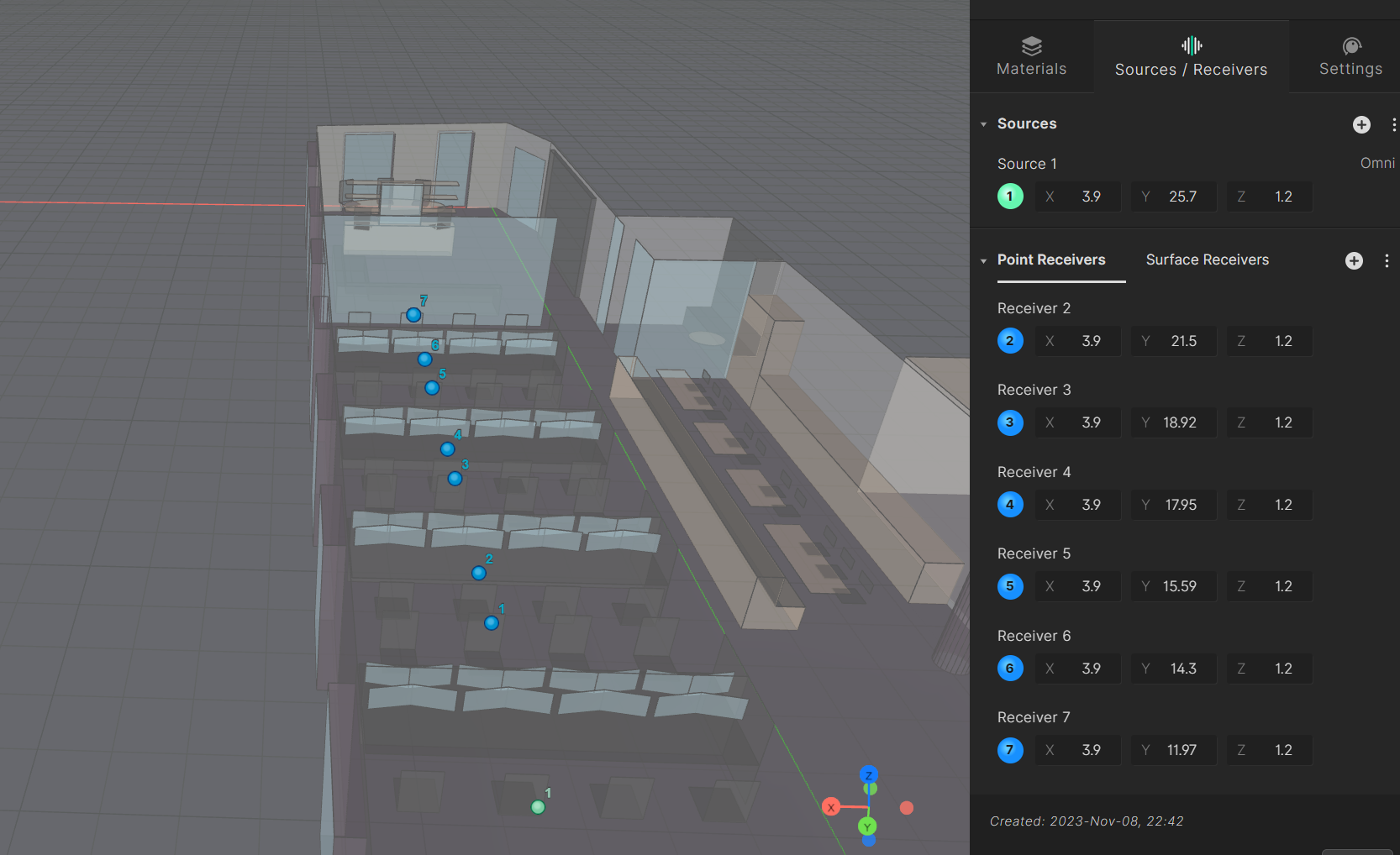Open Plan Office
Scope
This documentumentation details how to calculate the room acoustic parameters Open Plan Office Parameters (OOP) in Treble as specified in ISO 3382-3 2022 [2]
The international standard ISO 3382-3:2022 [2] defines several measurable room acoustic parameters for objective evaluation of the acoustical phenome of Open Plan Offices.
The standard describes acoustical behaviour (performance) lead to distraction and lack of speech privacy. Distraction reduces the ability to concentrate which reduces productivity. Low speech privacy prevents confidential conversation and speech can be intrusive for listener, it can be desirable to avoid involuntary spread of speech of a private nature.
Furniture strongly effects acoustic conditions. Therefore, design of the open plan office is crucial (for good sounding office, for productive working in environment) getting a good speech privacy between workstations with carefully chosen furniture, absorption materials and well as well-located dividers.
Single number quantities
The standard defines 4 single number quantities that desciribe the quality of the acoustics for the open plan office. Further the standard defines a sound zone, for the area where the single number quantities should be calculated for. To calculate them, the following measurements data or simulation data has to be calculated first. The sound pressure level and STI shall be measured/simulated in octave bands from 125 Hz to 8000 Hz. STI hall be determined in accordance with the full method specified in IEC 60268-16 [1].
The single number quantities that are determined are:
- Distraction distance,
- Spatial decay rate of A-weighted SPL of speech,
- A-weighted SPL of speech at 4m,
- ** Comfort distance, **
Additionally the background noise level has to be measured
- Average A-weighted background noise level,
Spatial decay rate of speech
Rate of spatial decay of speech, A-weighted sound pressure level per doubling of distance in decibels . This value is extracted from SPL values in octave bands from simulations and converted to speech levels following the "SPL of speech omnidirectional", also written as: .
is calculated according to formula (6) from [2], using a linear regression with a logarithmic distance axis.
A-weighted sound pressure level of speech at a distance of 4m
nominal A-weighted sound pressure level of normal speech at a distance of 4,0 m from the sound source. This value is calculated using the . Further detail in [2]
NOTE The measurement position does not need to be located at this distance from the sound source. is obtained using a linear regression line from the spatial sound distribution of the A-weighted sound pressure level (SPL) of speech.
Distraction distance
This number represents the distance from the speaker where the STI drops below 0,5. As stated in [2] : " Distraction distance, [m], is a predictor of the objective speech privacy of the the open-plan office." This number is expressed in meters. It is recommanded to view the Spatial Decay plot of the STI, this gives overview of the how STI is dropping over distance and where it goes below 0.5.
Comfort distance
Represent the discance where the A-weighted SPL of speech drops below 45 dB. A stated in [2] :"Comfort distance, describes the effect of spatial attenuation in the office without paying attention to speech privacy, background noise lebel, or sound masking."
Background noise level
Average background noise level in A-weighted dB SPL, during working hours with people absent. Currently available as Noise Criteria curves of different levels.
NC curves
NOTE Background noise here means all such continuous sounds, which are not caused by people, e.g. heating, ventilation and air conditioning (HVAC) devices, environmental traffic noise, office equipment or a sound-masking system.
Setting up a simulation to estimate ISO-3382-3 for a space
Based on the guidelines in the standard [2], it is suggested to align receivers along a trajectory crossing over workstations, aiming for the path to be as direct as possible. Ideally, the line should have 6 to 10 receivers, although the minimum acceptable number is 4.
Distance of each receiver to the nearest wall should be at least 1,0 m. According to the standard, you should verify if the last measurement position is close to a reflecting wall, then it should be ignored. This is due to the reflective wall can cause SPL and STI to be elevated in the last postion.
The sound source is located at the workstation at the end of the path. The distance from the source to the nearest table should be at least 0,4 m and the distance to the nearest wall shall be at least 1,0 m.
The placement of both the sound sources and receivers should be located at the position of a siitting occupant's head in a workstation which is considered 1,2 m above the floor.
The standard [2] states that the source should be omnidirectional. Treble expects a default omnidirectional source with the sound pressure level set at 94 dB in each octave band. Following formula (2) in [2], Treble then estimates the speech spectrum at each receiver by calculating the attenuation and applying it to the speech level prescribed in table 1 in [2].
The standard [2] is quite detailed with its measurement procedure. Please familiarize yourself with it if the intention is for the simulated environment to be fully compliant with the standard.
Once the simulation has been run the open plan office parameters are available in the Results view.
It is important to note that while the minimum requirement for receivers is 4 as per [2], our Open plan office parameters (OOP) results can accommodate configurations with 2 or more receivers.

References
[1] IEC 60268-16, Sound system equipment — Part 16: Objective rating of speech intelligibility by speech transmission index.
[2] ISO 3382-3:2022 Acoustics, Measurement of room acoustic parameters Part 3: Open plan offices